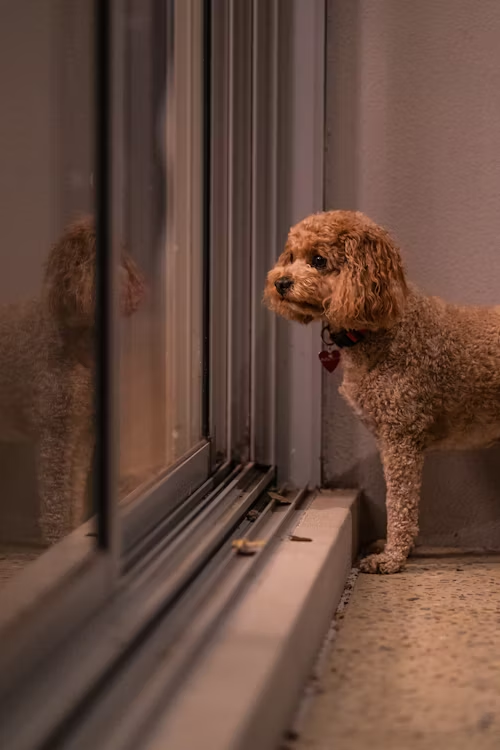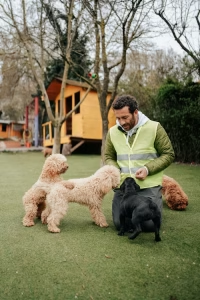Confidence Is the Foundation of Good Behavior
Not all training is about obedience. Sometimes, the real work starts with building your dog’s emotional security. Fearful or anxious dogs don’t need more commands — they need leadership, consistency, and calm exposure to the world around them.
Fear shows up in many forms. Some dogs shake or hide, others bark or lunge. Whether your dog cowers under the table or reacts defensively toward strangers, the root issue is often the same: they lack confidence.
In this blog, we’ll explore how to help your dog become more secure and stable through training techniques that build trust and resilience.
How to Recognize Fear-Based Behavior
Fear doesn’t always look like trembling or hiding. Some fearful dogs act bold or loud in order to push threats away. Others go into shutdown mode. Here are common signs of fear or anxiety:
-
Pacing, panting, or hyper-vigilance indoors
-
Avoiding eye contact or withdrawing from people
-
Startling easily at sounds, movement, or new objects
-
Barking, growling, or lunging out of perceived “defense”
-
Inability to settle, rest, or focus even in safe settings
Recognizing these signs is the first step toward building a plan to help your dog feel more grounded.
Why Punishment Doesn’t Work for Fear
Fearful behavior isn’t defiance — it’s a stress response. Correcting or punishing a dog for acting scared or overwhelmed often makes things worse. It can erode trust and reinforce the belief that the world is unsafe.
Instead, the focus should be on creating clear expectations, structured exposure, and repeatable success patterns.
Steps to Build Confidence in a Fearful Dog
1. Establish Daily Structure
Fearful dogs thrive with predictability. Set clear routines for feeding, walking, crate time, and training. Structure provides a sense of control and safety, especially for dogs who feel overwhelmed by change or unpredictability.
2. Limit Freedom to Build Focus
Too much freedom too soon can overwhelm anxious dogs. Use tools like crates, place training, and leashes inside the house to create small, safe zones. The more time your dog spends succeeding in a controlled setting, the more their confidence grows.
3. Use Gradual Exposure, Not Flooding
Introduce your dog to new people, dogs, environments, and sounds in a slow, intentional way. Start far from the trigger, pair the exposure with calm praise or food, and move closer only when your dog is relaxed.
Flooding — or forcing your dog into overwhelming situations — often backfires. Confidence grows from small victories, not emotional overload.
4. Teach Basic Obedience in Calm Environments
Simple commands like sit, place, and heel teach your dog how to listen and follow, which boosts confidence. Practice these in low-distraction environments first. Success in training builds emotional security and mental clarity.
5. Reward Neutrality, Not Just Obedience
If your dog ignores a loud noise or calmly observes a stranger without reacting, reward it. Calm neutrality is a skill that deserves reinforcement just like a perfect “sit.”
What to Avoid With Anxious Dogs
-
Coddling during fear responses: Petting or soothing a fearful dog in the moment can accidentally reinforce the fear
-
Overexposure to triggers: Going too fast can cause setbacks
-
Waiting for the dog to “grow out of it”: Confidence must be built through training, not time alone
-
Using high-energy greetings: Excitement increases arousal, which heightens anxiety in sensitive dogs
The Role of Handler Energy
Fearful dogs look to their humans for leadership. If you are anxious, inconsistent, or unsure, your dog will reflect that. Calm, clear, and confident energy communicates safety.
Use body language that says, “I’ve got this.” Breathe slowly, move with intention, and avoid overreacting. This stability helps your dog relax and trust your guidance.
When to Seek Professional Help
If your dog’s fear leads to aggression, severe reactivity, or prevents daily functioning, a professional trainer can help create a safe, structured desensitization plan. Early intervention can prevent long-term behavioral issues.
Final Thoughts: Confidence Is Trained, Not Inherited
No dog is born perfectly confident. Just like humans, dogs develop emotional resilience through experience, leadership, and encouragement. With patience, consistency, and the right structure, even the most anxious dog can learn to feel safe and capable.
Your dog doesn’t need a perfect environment — they need a calm, consistent leader who teaches them how to navigate the world one step at a time.



